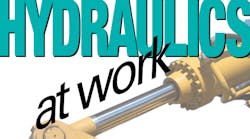In a previous blog post I discussed the true cost of hydraulic oil leaks. In the case of oil leaks, the cost areas that need to be considered include:
--Make-up fluid;
--Clean-up;
--Disposal;
--Contaminant ingress; and
--Safety.
But what about hydraulics' fluid power cousin: pneumatics? One of the advantages that pneumatics has over hydraulics is its clean-ness. Air leaks are much easier to ignore than oil leaks because they don't draw attention to themselves in the same way. You don't need to worry yourself with clean-up and disposal costs. Contaminant ingression is possible, but is generally not a major concern. And unless the leak is significant, safety is not usually a big issue either. So that leaves make-up fluid (air).
Make-up air
While air is free - clean, dry compressed air is not. In considering the cost of make-up air for a pneumatics system the following need to be considered:
--Depreciation (wear and tear) of the compressor;
--Conditioning costs - filtration, drying and lubrication; and
--Energy cost of compression.
The ideal leakage rate is of course zero, but when calculating the free air delivery (FAD) required by a pneumatic system a rule of thumb is to allow for leakage of 10% of total flow rate. Consider a 10 cubic meter/minute system leaking one cubic meter/minute. The power required to compress one cubic meter (35.3 cubic feet) of air per minute to a pressure of 6 bar (90 PSI) is approximately 5.2 kW. At an electricity cost of $0.10/kWh this leakage is costing over 50 cents per hour in electricity consumption alone. In a 24/7/365 operation that amounts to $4500 per year!
Calculating the cost
While a leakage rate of 10% of flow rate may sound high and would be unsustainable in a hydraulic system, air leakage rates as high as 25% are not unheard of - even in apparently well maintained pneumatic systems. The actual leakage rate of a system can be calculated using the following formula:
QL = QC* t / (T+t)
Where:
QL = System leakage rate (cubic meters/minute)
QC = Compressor FAD (cubic meters/minute)
T = Leakage time - time between compressor cut-out and cut-in (minutes)
t = Charging time - time between compressor cut-in and cut-out (minutes)
Note: this formula assumes that all system consumption is suspended while the leakage test is conducted.
Conclusion
As demonstrated by the above example, the annual cost of air leaks in pneumatic systems can be significant - in power consumption alone. Conduct regular leakage tests on your pneumatic systems and take necessary action to locate and rectify leaks as required. For more on the operation and maintenance of compressed air systems and pneumatic equipment visit: www.IndustrialPneumaticControl.com
And bottom line: tolerating leaks, whether they're air or oil is a costly mistake. And to discover six other costly mistakes you want to be sure to avoid with your hydraulic equipment, get "Six Costly Mistakes Most Hydraulics Users Make... And How You Can Avoid Them!" available for FREE download here.

